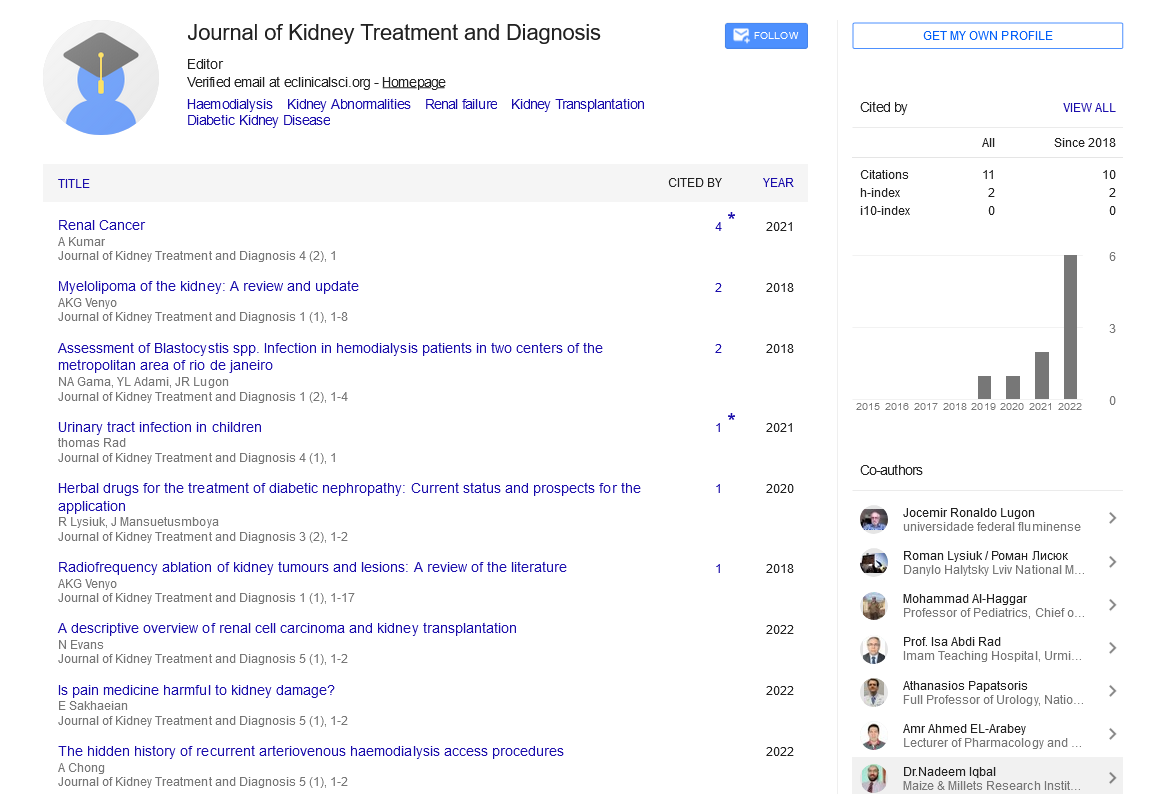The circadian rhythm in ckd patients
Received: 01-Jan-2021 Accepted Date: Jan 15, 2021; Published: 22-Jan-2021
Citation: Robert J. The Circadian rhythm in CKD patients . J Kidney Treat Diagn 2021; 4(1):3
This open-access article is distributed under the terms of the Creative Commons Attribution Non-Commercial License (CC BY-NC) (http://creativecommons.org/licenses/by-nc/4.0/), which permits reuse, distribution and reproduction of the article, provided that the original work is properly cited and the reuse is restricted to noncommercial purposes. For commercial reuse, contact reprints@pulsus.com
Description
The kidneys direct numerous imperative capacities that require exact control for the duration of the day. These capacities, for example, keeping up sodium equilibrium or directing blood vessel pressure, depend on a natural clock instrument that was regularly accepted to be constrained by the focal sensory system. Mounting proof lately has uncovered beforehand overlooked profundity of impact by circadian rhythms and clock qualities on renal capacity, at the atomic and physiological level, autonomous of other outside components. The effect of circadian rhythms in the kidney additionally influences people from a clinical viewpoint, as the deficiency of cadenced movement of clock quality articulation has been recorded in different cardiovascular infections.
This research enrolled 101 patients (52 male and 49 female) with CKD stages 1-5, who were admitted to Xiangya Hospital, Changsha, China from August 2017 to August 2018. CKD was defined as the reduced level of eGFR when they received the Pittsburgh Sleep Quality-Index (PSOI) questionnaire. Patients were screened by strict exclusion criteria. The clinical files included general information about patients and blood biochemical test data. Subjective sleep quality was assessed in all patients using the Pittsburgh Sleep Quality-Index (PSQI). The expression of circadian clock genes PER1 and CRY1 in peripheral blood leukocytes using quantitative RT-PCR and Western blotting. Some proteins regulating circadian rhythm may involve in sleep disorders and circadian clock gene decoded proteins, nuclear PER and CRY phytochrome (CRY), play a role in the regulation of circadian rhythm. We designed a questionnaire for patients with CKD stages 1-5 and investigated the levels of CRY mRNA and protein in PB lymphocytes. Research enrolled 101 patients (52 male and 49 female) with CKD stages 1-5. Subjective sleep quality was assessed using PSQI. The expression of circadian clock genes PER1 and CRY1 were tested in PB leukocytes using RT-PCR and WB. Sleep questionnaires were obtained from patients. There were significant differences between the group of PSQI ≤ 5 and PSQI > 5 in the aging and SCR index. PSQI score was negative correlated with the stage of CKD. Levels of PER1 and CRY1 in PBMC were highest in CKD 1 stage patients, while lowest in CKD stage 5. [1-3].
The progress of CKD was associated with the degree of sleep disorders. The score of PSQI was negatively correlated with lower eGFR. Hb, HCT, Alb, and ALT were significantly better in the group whose PSQI ≤ 5. There is a correlation between decreased sleep quality and elevated CRP levels. The more aging and CRP, the higher the PSQI score. PER1 and CRY1 were higher expressed in patients with CKD stage 1 and lowest in CKD stage 5 patients. The circadian rhythm of PBMCs was associated with the stage of CKD. Sleep questionnaires were obtained from the 101 patients from CKD stage 1 to 5. It also found that the PSQI score was negative correlated with the stage of CKD formed. The higher level of PER1 and CRY1 in PBMC of CKD stage 1 patients was confirmed by Western blot and qRT-PCR. It was also found that the expression of PER1 and CRY1 significantly down- regulated in the PBMC of CKD stage 5 patients [4-5].
Conclusion
The circadian rhythm can be also shown in human PBMCs. The proteins of per and CRY were two of period circadian clock proteins. In our research, we test that the expression of PER1 and CRY1 in PBMCs of patients with CKD. It found that PER1 and CRY1 were higher expressed in patients with CKD stage 1 and lowest in patients with CKD stage 5. It suggested that the circadian rhythm of PBMCs was associated with the stage of CKD. It was said that the function of PBMCs also is affected in CKD, such as the regulation of cellular calcium homeostasis, which can influence the circadian rhythm.
REFERENCES
- Stow, L. R. & Gumz, M. L. The circadian clock in the kidney. J. Am.Soc. Nephrol. 22, 598-604.
- Rakova, N. et al. Long-term space flight simulation reveals infradian rhythmicity in human Na(+) balance. Cell. Metabolism 17, 125-131.
- Bonny, O. & Firsov, D. Circadian regulation of renal function and potential role in hypertension. Curr. Opin. Nephrol. Hypertens. 22,439-444.
- Nikolaeva. The circadian clock modulates renal sodium handling. J.Am. Soc. Nephrol. 23, 1019-1026.
- Mauvoisin, D. Circadian and feeding rhythms orchestrate the diurnal liver acetylome. Cell Rep. 20, 1729–1743.





